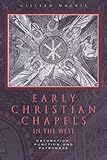Early Christian Chapels in the West : Decoration, Function, and Patronage / Gillian Mackie.
Material type: TextPublisher: Toronto : University of Toronto Press, [2003]Copyright date: ©2003Description: 1 online resource (512 p.)Content type:
TextPublisher: Toronto : University of Toronto Press, [2003]Copyright date: ©2003Description: 1 online resource (512 p.)Content type: - 9780802035042
- 9781442674189
- 726/.4
- NA5613
- online - DeGruyter
| Item type | Current library | Call number | URL | Status | Notes | Barcode | |
|---|---|---|---|---|---|---|---|
 eBook
eBook
|
Biblioteca "Angelicum" Pont. Univ. S.Tommaso d'Aquino Nuvola online | online - DeGruyter (Browse shelf(Opens below)) | Online access | Not for loan (Accesso limitato) | Accesso per gli utenti autorizzati / Access for authorized users | (dgr)9781442674189 |
Browsing Biblioteca "Angelicum" Pont. Univ. S.Tommaso d'Aquino shelves, Shelving location: Nuvola online Close shelf browser (Hides shelf browser)

|

|

|

|

|

|

|
||
| online - DeGruyter E. Pauline Johnson, Tekahionwake : Collected Poems and Selected Prose / | online - DeGruyter E.J. Pratt : Complete Poems / | online - DeGruyter Early Canadian Printing : A Supplement to Marie Tremaine's 'A Bibliography of Canadian Imprints, 1751 - 1800' / | online - DeGruyter Early Christian Chapels in the West : Decoration, Function, and Patronage / | online - DeGruyter Early Modern Catholicism : Essays in Honour of John W. O'Malley, S.J. / | online - DeGruyter East Asia in Transition : Economic and Security Challenges / | online - DeGruyter East Asian Capitalism : Diversity and Dynamism / |
restricted access online access with authorization star
http://purl.org/coar/access_right/c_16ec
Chapels were among the important types of buildings that evolved during the first four centuries of organised Christianity in the West. They were originally developed in connection with the cult of the saints, commemorating both their gravesites and their places of martyrdom. But the chapels rapidly found other uses among the ever-expanding Christian population as places of prayer and pilgrimage, and were chosen by the faithful for their own burial beside the saints.With little in the way of contemporary written records, the decorative programme of each chapel is now often the only way to determine the function, patronage, and meaning of the building. Gillian Mackie examines the decorative schemes of the surviving chapels built in Italy and Istria from AD312-740 in the context of numerous chapels known from archaeological sites or from later medieval texts. Using the decoration as the primary source of evidence on the buildings' use and meaning, this survey includes chapels, imperial mausolea, and the oratories of the popes and bishops, from Rome, Milan, Ravenna, and the smaller centres of the upper Adriatic. The author begins with an overview of the various types, and then discusses several of the most complete monuments in considerable detail. Unique in its scope and approach, Mackie's survey of the functional context of early medieval chapels is the most complete work ever published in its field and will be an important reference work for anyone interested in medieval art and architecture.
Mode of access: Internet via World Wide Web.
In English.
Description based on online resource; title from PDF title page (publisher's Web site, viewed 01. Nov 2023)


